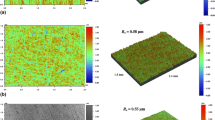Abstract
Wear tests were conducted using a ball-on-disc tester. In the experiment, a 42CrMo4 steel disc with ahardness of 40HRC was placed in contact with a 100Cr6 steel ball with adiameter of 6.35 mm. The hardnessof the ball was setto62HRC. Disc samples were preparedto obtain surfaces in range to the Sq parameter but of less than 0.5 mm. Dry tests were carried out. During the tests, the friction force was monitored as a function of time. Disc and ball wear was measured after the tests using a white light interferometer Talysurf CCI Lite. To decrease variations in the experimental results, during the tests, wear debris was continu-ously removed from the disc surfaces. It was found that the initial surface topography has a significant influence on friction and wear levels under dry sliding conditions. It was also identified the correlation between several surface topography parameters and friction and wear.
Similar content being viewed by others
References
Bhushan, Modern Tribology Handbook, CRC Press, 2001.
M.K. Besharati-Givi, P. Asadi, Advances in Friction-Stir Welding and Processing, first ed., Elsevier, 2014.
K. Kato, Wear in relation to friction - a review, Wear 241 (2000) 151–157.
P.J. Blau, Four great challenges conforming our understanding and modeling of sliding friction, in: Proceedings of the 24th Leeds-Lyon Symposium on Tribology, 1997.
M. Walczak, D. Pieniak, M. Zwierzchowski, The tribological characteristics of SiC particle reinforced aluminium composites, Archives of Civil and Mechanical Engineering 15 (2015) 116–123.
A. Dzierwa, P. Pawlus, W. Zelasko, R. Reizer, The study of the tribological properties of one-process and two-process textures after vapour blasting and lapping using pin-on-disc tests, Key Engineering Materials 527 (2013) 217–222.
N. Selvakumar, S.C. Singh, Influence of nano ZrC content on tribological analysis, microstructure and mechanical properties of Cu-4Cr matrix composites produced by hot extrusion, Archives of Civil and Mechanical Engineering 16 (2016) 537–552.
A. Dzierwa, P. Pawlus, W. Zelasko, Comparison of tribological behaviors of one-process and two-process steel surfaces in ball-on-disc tests, Proceedings of the Institution of Mechanical Engineers Part J-Journal of Engineering Tribology 228 (2014) 1195–1210.
M. Sedlacek, L.M. Silva Vilhena, B. Podgornik, J. Vizintin, Surface topography modelling for reduced friction, Strojniski vestnik -Journal of Mechanical Engineering 57 (9) (2011) 674–680.
F. Svahn, A. Kassaman-Rudolphi, E. Wallen, The influence of surface roughness on friction and wear of machine element coatings, Wear 254 (2003) 1092–1098.
N. Tayebi, AA. Polycarpou, Modeling the effect of skewness and kurtosis on the static friction coefficient of rough surfaces, Tribology International 37 (2004) 491–505.
W.R. Chang, M. Hirvonen, R. Gronqvist, The effects of cut-off length on surface roughness parameters and their correlation with transition friction, Safety Science 42 (2004) 755–769.
J. Sep, P. Pawlus, L. Galda, The effect of helical groove geometry on journal abrasive wear, Archives of Civil and Mechanical Engineering 13 (2013) 150–157.
R. Reizer, L. Galda, A. Dzierwa, P. Pawlus, Simulation of textured surface topography during a low wear process, Tribology International 44 (2011) 1309–1319.
S. Wang, Y-Z. Hu, W-Z. Wang, H. Wang, Transition of frictional states and surface roughness affects in lubricated contacts, Proceedings of the Institution of Mechanical Engineers Part J-Journal of Engineering Tribology 222 (2008) 407–414.
S. Wang, Y-Z. Hu, Q.-C. Tan, Frictional behaviour of engineering surfaces in overall lubrication regimes of point contacts, Proceedings of the Institution of Mechanical Engineers Part J-Journal of Engineering Tribology 225 (2011) 1071–1080.
J. Michalski, P. Pawlus, Description of honed cylinders surface topography, International Journal of Machine Tools and Manufacture 34 (1994) 199–210.
W. Wieleba, The statistical correlation of the coefficient of friction and wear rate of PTFE composites with steel counterface roughness and hardness, Wear 252 (9-10) (2002) 719–729.
P.L. Menezes, S.V. Kailas, Kishore, Influence of roughness parameters on coefficient of friction under lubricated conditions, Sadhana - Academy Proceedings in Engineering Sciences 33 (3) (2008) 181–190.
R. Singh, S.N. Melkote, F. Hashimoto, Frictional response of precision finished surfaces in pure sliding, Wear 258 (10) (2005) 1500–1509.
X. Liu, G. Chetwynd, J.W. Gardner, Surface characterization of electro-active thin polymeric film bearings, International Journal of Machine Tools and Manufacture 38 (5-6) (1998) 669–675.
P. Nyman, R. Maki, R. Olsson, B. Ganemi, Influence of surface topography on friction characteristics in wet clutch applications, Wear 261 (1) (2006) 46–52.
M. Sedlacek, B. Podgornik, J. Vizintin, Influence of surface preparation on roughness parameters, friction and wear, Wear 266 (2009) 482–487.
M. Sedlacek, B. Podgornik, J. Vizintin, Correlation between standard roughness parameters skewness and kurtosis and tribological behaviour of contact surfaces, Tribology International 48 (2012) 102–112.
W. Grabon, P. Pawlus, J. Sep, Tribological characteristics of one-process and two-process cylinder liner honed surfaces under reciprocating sliding conditions, Tribology International 43 (2010) 1882–1892.
R. Leach (Ed.), Characterisation of Areal Surface Texture, Springer-Verlag, Berlin, Heidelberg, 2013.
M. Niemczewska-Wojcik, A. Mankowska-Snopczynska, W. Piekoszewski, The investigation of wear tracks with the use of non-contact measurement methods, Archives of Civil and Mechanical Engineering 13 (2013) 158–167.
L. Chang, Y.R. Jeng, Effects of negative skewness of surface roughness on the contact and lubrication of nominally flat metallic surfaces, Proceedings of the Institution of Mechanical Engineers Part J-Journal of Engineering Tribology 227 (2012) 556–569.
J.I. McCool, Non-Gaussian effects in microcontact, International Journal of Machine Tools and Manufacture 32 (1992) 115–123.
N. Yu, A.A. Polycarpou, Contact of rough surfaces with asymmetric distribution of asperity heights, ASME Journal of Tribology 124 (2002) 367–376.
G. Macias, M. Alba, L.F. Marsal, A. Mihi, Surface roughness boosts the SERS performance of imprinted plasmonic architectures, Journal of Materials Chemistry C 4 (2016) 3970–3975.
T. Zhu, E. Ertekin, Phonons, localization, and thermal conductivity of diamond nanothreads and amorphous graphene, Nano Letters 16 (2016) 4763–4772.
T. Zhu, E. Ertekin, Generalized Debye-Peierls/Allen-Feldman model for the lattice thermal conductivity of low-dimensional and disordered materials, Physics Review B 93 (2016) 155414 (1-11).
Author information
Authors and Affiliations
Corresponding author
Rights and permissions
About this article
Cite this article
Dzierwa, A. Influence of surface preparation on surface topography and tribological behaviours. Archiv.Civ.Mech.Eng 17, 502–510 (2017). https://doi.org/10.1016/j.acme.2016.12.004
Received:
Accepted:
Published:
Issue Date:
DOI: https://doi.org/10.1016/j.acme.2016.12.004




